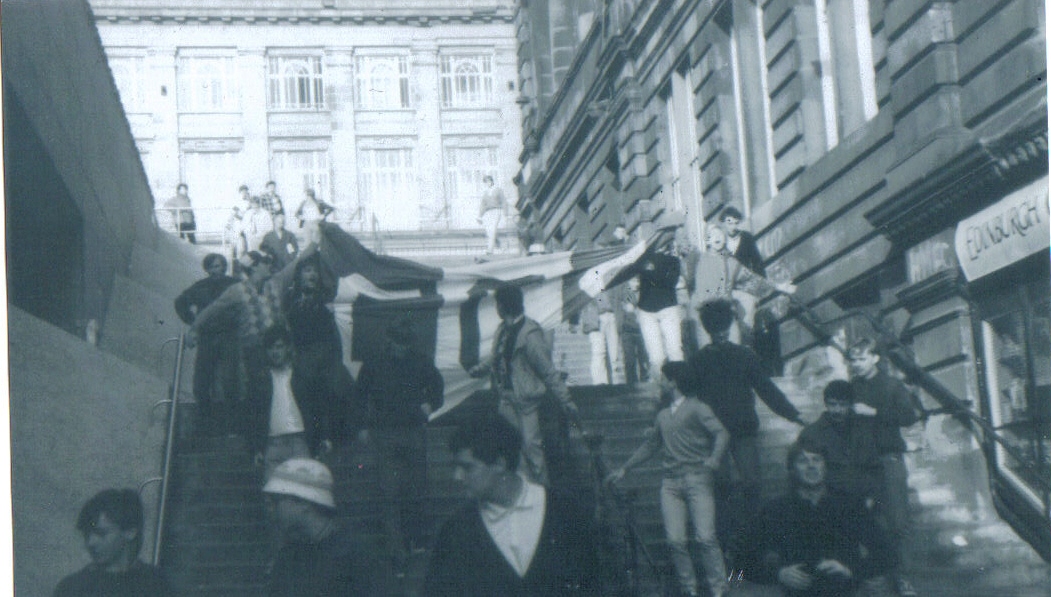The Capital City Service (CCS) is a Scottish football hooligan firm associated with Hibernian and active from 1984 when the casual hooligan subculture took off in Scotland. Their roots were in the previous incarnations of hooligans attached to the club and also the wider Edinburgh and surrounding areas gang culture. They are more commonly known in the media and amongst the general public as the Hibs Casuals though within the hooligan network they may also be referred to as Hibs boys.
Hooliganism was established at matches with many clubs in Scottish football before the advent of the casuals and violence with Hibs thugs was recognised as likely to occur by other teams hooligan supporters. The CCS went on to be regarded by some rivals and observers as the dominant hooligan gang in the Scottish scene between the latter part of the 1980s until the mid 1990s and also from outside Scotland as one of the best from north of the border.
During the latter part of the 1990s a split in their ranks caused by the formation of a nationwide hooligan firm made up of casuals from different teams and a general decline in football hooliganism in Scotland saw activity of the gang diminish. However by the early part of the next decade an apparent resurgence in football hooliganism at various clubs in Scotland was being observed by authorities and the CCS attached to Hibernian were involved.
In the early 1980s Hibs away fixtures were regularly attended by fans on supporters buses from amongst areas in Edinburgh such as Leith, Niddrie, Tollcross and Granton. This afforded the opportunity for bonds to be forged through the shared experiences of following the team and responding to the actions of opposing fans. An away match in November 1983 against Airdrie resulted in a clash with the well known local hooligans, Section B, which further strengthened these connections and helped bolster the young Hibs boys confidence into forming a casual-style hooligan firm. This new friendship of youths from different areas of the city was a contrast to the existing area gang ethos that had been a feature of the capital since the 1950s. The camaraderie branched out from match days as the gang members also hung about with each other during the week. Word soon got round and the basis of the first known unified Edinburgh gang was in place.
Article continues below
Edinburgh at that time had become known as the AIDS capital of Europe due to the rampant heroin use that existed there. Coupled with the ongoing poor economic climate throughout the country, for young men who wished to maintain pride in themselves as well as a sense of belonging to something the new casual hooligan culture was an alternative route to embark upon.
However, the congeniality was not a constant throughout the rest of the Hibs support who, in the main, still wore team colours at matches. Referred to as scarfers, or more playfully as cavemen by the Hibs boys, a popular chant at the time that was adopted by some Hibs scarfers was ‘Oh it’s magic, you know, Hi-bees and casuals don’t go’ and this dislike was tangible at home matches between the CCS and other sections of the Hibs crowd.
A pivotal moment in this formative season was when the CCS encountered the leading casual gang at the time in Scotland – the Aberdeen Soccer Casuals – before a Hibs v. Aberdeen game in Edinburgh. The two mobs clashed on Easter Road and after some fighting the CCS ran away but one Hibs boy got severely beaten and was in a coma for a week. Rather than deter them this near-tragedy emboldened the fledgling gang to continue with their efforts in being casual hooligans. At the next Hibs match which was against local rivals Hearts at Tynecastle the CCS fared a lot better when they came up against the notorious Gorgie Aggro and this also proved to be a turning point in the Edinburgh football hooligan scene.
As the CCS evolved an informal hierarchy appeared but there was no singular leader or ‘top boy’ as was usual for other crews. Instead a committee of five individuals who had garnered enough respect amongst their peers took to the task of planning and organising for the gangs activities at football. By the early to mid-1990s this system had expired and was replaced mainly by two protagonists who arranged most battles and who were also striving for control of the mob.
Membership wasn’t even restricted to only Hibs fans. Over the years casuals from Hearts and sometimes Old Firm fans who lived in Edinburgh were integrated into the mob. These individuals usually had a more rigorous initiation than normal as asides from the reservations of some CCS members they also had to prove their worth against the team that they were originally associated with.
Article continues below
There was also the need initially for hooligans younger than ones in the main mob to form their own identifiable group and could also be managed and trained by older more experienced hooligans. In later times a type of apprenticeship scheme was used to enable the veterans in the CCS to select and mentor prospective younger hooligans. Eventually some offspring of Hibs casuals took to being the new younger additions to the Hibs mob. This father-to-son tradition also occurred with other mobs as was exampled in action when sons from the CCS and CSF were involved in an altercation outside an entertainment complex in Edinburgh.
The following is a list of elements of the CCS that are recognised internally by the gang as well as outside parties.
Blackleys Baby Crew (BBC) – Formed in 1985 mainly by the younger siblings and associates of the original members. Named after the manager of the football club at the time,John Blackley. This group was dissolved once its prolific members attained full acceptance by the main mob.
Lassie Soccer Trendies (LST) – Females who were either girlfriends or groupies of CCS members. The older or more male only gang purists amongst the CCS were often embarrassed by the existence of this set of wanna-be gang members. Despite these reservations this group flourished and was never really dropped completely until 1988, though by then the women involved in it had taken on a more jocular approach to what they had participated in.
The Family – In 1986 a hardcore section of the gang wanted to create a specific identity for the most dedicated and enthusiastic members. The nomenclature of CCS was felt by the participants to be the generic title for all casual hooligans who had attached themselves to Hibernian regardless of the individuals capabilities or reputation.
Hibs Baby Crew (HBC) – Circa 1987 the popularity of football hooliganism and of the CCS activities had attracted another set of young and eager recruits in much the same way as the previous baby crew. The dissolution of this group followed the same pattern as the BBC. By the early part of the 21st century there was a further wave of casual styled hooligans attached to Hibernian who had resurrected the moniker of the Hibs Baby Crew. This consisted of youths attracted to football hooliganism for similar reasons as their predecessors and quite often enough they could have been sons or nephews of older hooligans.
Disorder
The CCS has had clashes all across Scotland, England and Europe either when Hibernian or Scotland were playing or as invited guests of other English hooligan firms at various English league games. There have been instances of them making an appearance at Scottish or English club matches without the prior knowledge of the hooligan element of the teams playing each other that day.
Pre-season friendlies that were played against English clubs such as Newcastle United, Oldham Athletic, Burnley, Aston Villa, Millwall, Leeds United, Preston North End, Sunderland, Bolton Wanderers and Nottingham Forest have also led to hooligan incidents. One friendly at home that had been arranged with Chelsea in the early 1990s had potentially serious trouble averted by police action against a travelling group of well known Chelsea hooligans.
Article continues below
Videos

